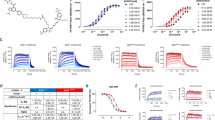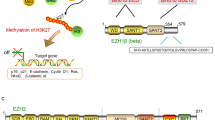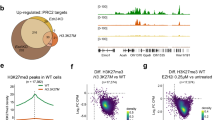Abstract
Aberrant activity of enhancer of zeste homolog 2 (EZH2) is associated with a wide range of human cancers. The interaction of EZH2 with embryonic ectoderm development (EED) is required for EZH2's catalytic activity. Inhibition of the EZH2-EED complex thus represents a novel strategy for interfering with the oncogenic potentials of EZH2 by targeting both its catalytic and non-catalytic functions. To date, there have been no reported high-throughput screening (HTS) assays for inhibitors acting at the EZH2-EED interface. In this study, we developed a fluorescence polarization (FP)-based HTS system for the discovery of EZH2-EED interaction inhibitors. The tracer peptide sequences, positions of fluorescein labeling, and a variety of physicochemical conditions were optimized. The high Z' factors (>0.9) at a variety of DMSO concentrations suggested that this system is robust and suitable for HTS. The minimal sequence requirement for the EZH2-EED interaction was determined by using this system. A pilot screening of an in-house compound library containing 1600 FDA-approved drugs identified four compounds (apomorphine hydrochloride, oxyphenbutazone, nifedipine and ergonovine maleate) as potential EZH2-EED interaction inhibitors.
Similar content being viewed by others
Log in or create a free account to read this content
Gain free access to this article, as well as selected content from this journal and more on nature.com
or
References
Simon JA, Kingston RE . Mechanisms of polycomb gene silencing: knowns and unknowns. Nat Rev Mol Cell Biol 2009; 10: 697–708.
Tan JZ, Yan Y, Wang XX, Jiang Y, Xu HE . EZH2: biology, disease, and structure-based drug discovery. Acta Pharmacol Sin 2014; 35: 161–74.
Liu Q, Wang MW . Histone lysine methyltransferases as anti-cancer targets for drug discovery. Acta Pharmacol Sin 2016; 37: 1273–80.
McCabe MT, Graves AP, Ganji G, Diaz E, Halsey WS, Jiang Y, et al. Mutation of A677 in histone methyltransferase EZH2 in human B-cell lymphoma promotes hypertrimethylation of histone H3 on lysine 27 (H3K27). Proc Natl Acad Sci U S A 2012; 109: 2989–94.
Morin RD, Johnson NA, Severson TM, Mungall AJ, An J, Goya R, et al. Somatic mutations altering EZH2 (Tyr641) in follicular and diffuse large B-cell lymphomas of germinal-center origin. Nat Genet 2010; 42: 181–5.
Ryan RJ, Nitta M, Borger D, Zukerberg LR, Ferry JA, Harris NL, et al. EZH2 codon 641 mutations are common in BCL2-rearranged germinal center B cell lymphomas. PLoS One 2011; 6: e28585.
Sneeringer CJ, Scott MP, Kuntz KW, Knutson SK, Pollock RM, Richon VM, et al. Coordinated activities of wild-type plus mutant EZH2 drive tumor-associated hypertrimethylation of lysine 27 on histone H3 (H3K27) in human B-cell lymphomas. Proc Natl Acad Sci U S A 2010; 107: 20980–5.
Behrens C, Solis LM, Lin H, Yuan P, Tang X, Kadara H, et al. EZH2 protein expression associates with the early pathogenesis, tumor progression, and prognosis of non-small cell lung carcinoma. Clin Cancer Res 2013; 19: 6556–65.
Chen Y, Xie D, Yin Li W, Man Cheung C, Yao H, Chan CY, et al. RNAi targeting EZH2 inhibits tumor growth and liver metastasis of pancreatic cancer in vivo. Cancer lett 2010; 297: 109–16.
Fussbroich B, Wagener N, Macher-Goeppinger S, Benner A, Falth M, Sultmann H, et al. EZH2 depletion blocks the proliferation of colon cancer cells. PLoS One 2011; 6: e21651.
He LJ, Cai MY, Xu GL, Li JJ, Weng ZJ, Xu DZ, et al. Prognostic significance of overexpression of EZH2 and H3k27me3 proteins in gastric cancer. Asian Pac J Cancer Prev 2012; 13: 3173–8.
Kleer CG, Cao Q, Varambally S, Shen R, Ota I, Tomlins SA, et al. EZH2 is a marker of aggressive breast cancer and promotes neoplastic transformation of breast epithelial cells. Proc Natl Acad Sci U S A 2003; 100: 11606–11.
Varambally S, Dhanasekaran SM, Zhou M, Barrette TR, Kumar-Sinha C, Sanda MG, et al. The polycomb group protein EZH2 is involved in progression of prostate cancer. Nature 2002; 419: 624–9.
Weikert S, Christoph F, Kollermann J, Muller M, Schrader M, Miller K, et al. Expression levels of the EZH2 polycomb transcriptional repressor correlate with aggressiveness and invasive potential of bladder carcinomas. Int J Mol Med 2005; 16: 349–53.
Béguelin W, Popovic R, Teater M, Jiang Y, Bunting KL, Rosen M, et al. EZH2 is required for germinal center formation and somatic EZH2 mutations promote lymphoid transformation. Cancer cell 2013; 23: 677–92.
Garapaty-Rao S, Nasveschuk C, Gagnon A, Chan EY, Sandy P, Busby J, et al. Identification of EZH2 and EZH1 small molecule inhibitors with selective impact on diffuse large B cell lymphoma cell growth. Chem Biol 2013; 20: 1329–39.
Knutson SK, Wigle TJ, Warholic NM, Sneeringer CJ, Allain CJ, Klaus CR, et al. A selective inhibitor of EZH2 blocks H3K27 methylation and kills mutant lymphoma cells. Nat Chem Biol 2012; 8: 890–6.
McCabe MT, Ott HM, Ganji G, Korenchuk S, Thompson C, Van Aller GS, et al. EZH2 inhibition as a therapeutic strategy for lymphoma with EZH2-activating mutations. Nature 2012; 492: 108–12.
Qi W, Chan H, Teng L, Li L, Chuai S, Zhang R, et al. Selective inhibition of Ezh2 by a small molecule inhibitor blocks tumor cells proliferation. Proc Natl Acad Sci U S A 2012; 109: 21360–5.
Kim KH, Kim W, Howard TP, Vazquez F, Tsherniak A, Wu JN, et al. SWI/SNF-mutant cancers depend on catalytic and non-catalytic activity of EZH2. Nat Med 2015; 21: 1491–6.
Lee ST, Li Z, Wu Z, Aau M, Guan P, Karuturi RK, et al. Context-specific regulation of NF-kappaB target gene expression by EZH2 in breast cancers. Mol cell 2011; 43: 798–810.
Xu K, Wu ZJ, Groner AC, He HH, Cai C, Lis RT, et al. EZH2 oncogenic activity in castration-resistant prostate cancer cells is Polycomb-independent. Science 2012; 338: 1465–9.
Chen H, Gao S, Li J, Liu D, Sheng C, Yao C, et al. Wedelolactone disrupts the interaction of EZH2-EED complex and inhibits PRC2-dependent cancer. Oncotarget 2015; 6: 13049–59.
Han Z, Xing X, Hu M, Zhang Y, Liu P, Chai J . Structural basis of EZH2 recognition by EED. Structure 2007; 15: 1306–15.
Kim W, Bird GH, Neff T, Guo G, Kerenyi MA, Walensky LD, et al. Targeted disruption of the EZH2-EED complex inhibits EZH2-dependent cancer. Nat Chem Biol 2013; 9: 643–50.
Kong X, Chen L, Jiao L, Jiang X, Lian F, Lu J, et al. Astemizole arrests the proliferation of cancer cells by disrupting the EZH2-EED interaction of polycomb repressive complex 2. J Med Chem 2014; 57: 9512–21.
Arkin MR, Wells JA . Small-molecule inhibitors of protein-protein interactions: progressing towards the dream. Nat Rev Drug Discov 2004; 3: 301–17.
Zinzalla G, Thurston DE . Targeting protein-protein interactions for therapeutic intervention: a challenge for the future. Future Med Chem 2009; 1: 65–93.
Gill SC, von Hippel PH . Calculation of protein extinction coefficients from amino acid sequence data. Anal Biochem 1989; 182: 319–26.
Zhang TT, Huang ZT, Dai Y, Chen XP, Zhu P, Du GH . High-throughput fluorescence polarization method for identifying ligands of LOX-1. Acta Pharmacol Sin 2006; 27: 447–52.
Zhang JH, Chung TD, Oldenburg KR . A simple statistical parameter for use in evaluation and validation of high throughput screening assays. J Biomol Screen 1999; 4: 67–73.
Li D, Han Q, Yang XY, Rong DM, Lin ZJ . Effects of kappa-selenocarrageenan on membrane fluidity and ghost reseal ability of rat erythrocyte. Acta Pharmacol Sin 1994; 15: 211–4.
Nikolovska-Coleska Z, Wang R, Fang X, Pan H, Tomita Y, Li P, et al. Development and optimization of a binding assay for the XIAP BIR3 domain using fluorescence polarization. Anal Biochem 2004; 332: 261–73.
Cao R, Zhang Y . SUZ12 is required for both the histone methyl-transferase activity and the silencing function of the EED-EZH2 complex. Mol Cell 2004; 15: 57–67.
Czermin B, Melfi R, McCabe D, Seitz V, Imhof A, Pirrotta V . Drosophila enhancer of Zeste/ESC complexes have a histone H3 methyltransferase activity that marks chromosomal Polycomb sites. Cell 2002; 111: 185–96.
Jiao L, Liu X . Structural basis of histone H3K27 trimethylation by an active polycomb repressive complex 2. Science 2015; 350: aac4383.
Brooun A, Gajiwala KS, Deng YL, Liu W, Bolanos B, Bingham P, et al. Polycomb repressive complex 2 structure with inhibitor reveals a mechanism of activation and drug resistance. Nat commun 2016; 7: 11384.
Arkin MR, Glicksman MA, Fu H, Havel JJ, Du Y . Inhibition of protein-protein interactions: non-cellular assay formats. In: Sittampalam GS, Coussens NP, Nelson H, Arkin M, Auld D, Austin C, Bejcek B, et al. editors. Assay Guidance Manual. Bethesda (MD); 2004.
Chen X, Ji ZL, Chen YZ . TTD: Therapeutic target database. Nucleic Acids Res 2002; 30: 412–5.
Kvernmo T, Houben J, Sylte I . Receptor-binding and pharmacokinetic properties of dopaminergic agonists. Curr Top Med Chem 2008; 8: 1049–67.
Banks P, Gosselin M, Prystay L . Impact of a red-shifted dye label for high throughput fluorescence polarization assays of G protein-coupled receptors. J Biomol Screen 2000; 5: 329–34.
Acknowledgements
The authors disclose the following financial support for this research and/or authorship of this article: the Ministry of Science and Technology of China (2015CB910304 to Hua-liang JIANG), the National Natural Science Foundation of China (21472208 and 81625022 to Cheng LUO, 21210003, 81230076 and 91313000 to Hua-liang JIANG), and the Fund of the State Key Laboratory of Toxicology and Medical Countermeasures, Academy of Military Medical Science (TMC201505 to Cheng LUO). We are extremely grateful to the National Centre for Protein Science Shanghai (Shanghai Science Research Center, Protein Expression and Purification System) for providing instrument support and technical assistance.
Author information
Authors and Affiliations
Corresponding authors
Additional information
Supplementary information is available at the website of Acta Pharmacologica Sinica.
Supplementary information
Supplementary Information
Supplementary Figure S1–S2. (DOC 2542 kb)
Supplementary Table S1
List of compound information in the pilot screening. (DOC 1297 kb)
Rights and permissions
About this article
Cite this article
Zhu, Mr., Du, Dh., Hu, Jc. et al. Development of a high-throughput fluorescence polarization assay for the discovery of EZH2-EED interaction inhibitors. Acta Pharmacol Sin 39, 302–310 (2018). https://doi.org/10.1038/aps.2017.59
Received:
Accepted:
Published:
Issue date:
DOI: https://doi.org/10.1038/aps.2017.59
Keywords
This article is cited by
-
Identification of novel EED-EZH2 PPI inhibitors using an in silico fragment mapping method
Journal of Computer-Aided Molecular Design (2021)
-
EZH2: a novel target for cancer treatment
Journal of Hematology & Oncology (2020)
-
Identification of small molecule inhibitors targeting the SMARCA2 bromodomain from a high-throughput screening assay
Acta Pharmacologica Sinica (2018)



